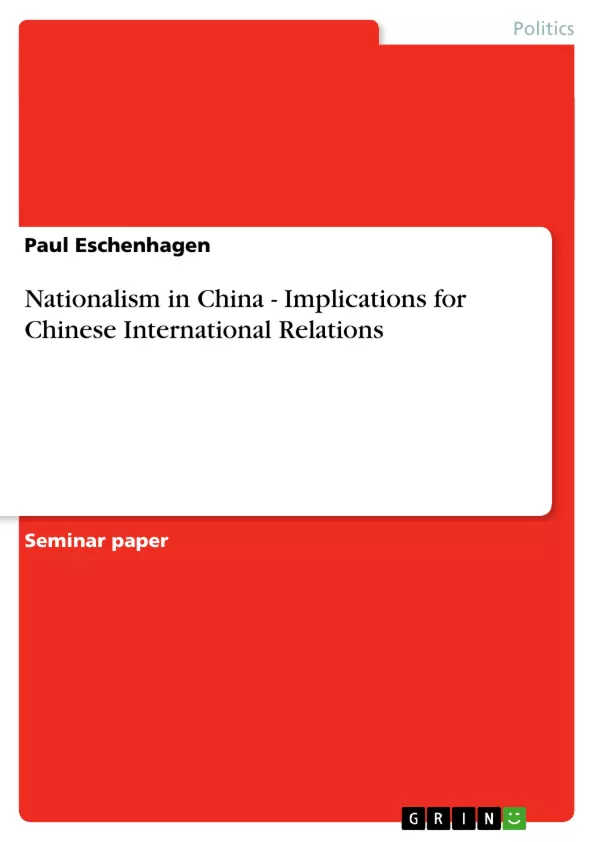In the past, Chinese nationalism has shown great flexibility as a connection of contradiction, interaction, and integration between the Communist Party, state and society, between the ruling ideology and intellectual discourse. Nationalism had great effect on the ways Chinese leaders and people behaved in domestic affairs, but also on the stage of international relations. Chinese nationalist thinking is not a uniform and unchanging phenomenon, as some Western analysts suggest, but a complex phenomenon with different layers which have to be analyzed in their complexity to come to a conclusion.
Inhaltsverzeichnis (Table of Contents)
- Introduction
- Definition, origin, and history of Chinese nationalism
- Nationalism in Chinese Foreign Affairs
- The Indian border war of 1962
- The Spratly Islands dispute
- The Diaoyu Islands
- The bombing of the Chinese embassy in Belgrade 1999
- The 2001 US spy plane incident
- The anti-Japanese demonstrations in 2005
- The Construction of nationalism
- State-led nationalism – “Party propaganda”
- Social construction of nationalism – “saving face”
- Forms of Chinese nationalism
- Ethnic, traditional and nativist nationalism
- Antitraditional and liberal nationalism
- Pragmatic and realistic nationalism
Zielsetzung und Themenschwerpunkte (Objectives and Key Themes)
This term paper aims to examine several aspects and forms of nationalism in general and Chinese nationalism in particular, focusing on the implications of nationalism for Chinese international relations. It will analyze how Chinese nationalism is constructed and highlight its various forms, demonstrating that it is not a uniform and unchanging phenomenon but a complex issue with different layers that require nuanced analysis.
- Definition and historical development of Chinese nationalism
- Manifestations of Chinese nationalism in international relations
- Construction of Chinese nationalism: State-led propaganda and social factors
- Forms of Chinese nationalism: Ethnic, antitraditional, and pragmatic
- The complex and multifaceted nature of Chinese nationalism
Zusammenfassung der Kapitel (Chapter Summaries)
- Introduction: Introduces the topic of Chinese nationalism and its significance in shaping China's domestic and international relations, highlighting the need for a nuanced analysis of its diverse forms.
- Definition, origin, and history of Chinese nationalism: Explores the definition of "nation" and "nationalism," highlighting the evolution of nationalism in China from its roots in culturalism to the rise of modern nationalism during the 19th and 20th centuries. It discusses the impact of the Opium Wars, the Boxer Rebellion, and the May Fourth Movement in shaping Chinese nationalist sentiment.
- Nationalism in Chinese Foreign Affairs: Examines various examples of how Chinese nationalism has manifested in international relations, focusing on issues of territorial integrity and national dignity. The chapter delves into the Chinese-Indian border war of 1962, the Spratly and Diaoyu Islands disputes, the bombing of the Chinese embassy in Belgrade, the 2001 US spy plane incident, and the anti-Japanese demonstrations of 2005.
- The Construction of nationalism: Contrasts two perspectives on the construction of Chinese nationalism: the Western view of state-led propaganda and the concept of "face nationalism" developed by Peter Hays Gries, which emphasizes the sociopsychological fundamentals of nationalism.
- Forms of Chinese nationalism: Presents different perspectives on Chinese nationalism, each rooted in a particular assessment of China's national interests and challenges. It explores ethnic, antitraditional, and pragmatic forms of nationalism and illustrates these with diverse examples of China's foreign relations.
Schlüsselwörter (Keywords)
This term paper explores the multifaceted nature of Chinese nationalism, encompassing its definition, origins, historical development, manifestations in foreign affairs, construction through state-led propaganda and social factors, and various forms like ethnic, antitraditional, and pragmatic nationalism. It delves into specific international relations issues like the Indian border war, the Spratly and Diaoyu Islands disputes, the bombing of the Chinese embassy in Belgrade, the 2001 US spy plane incident, and the anti-Japanese demonstrations of 2005. The paper emphasizes the complex and often contradictory nature of Chinese nationalism and its significant role in shaping China's domestic and international relations.
- Quote paper
- Paul Eschenhagen (Author), 2006, Nationalism in China - Implications for Chinese International Relations, Munich, GRIN Verlag, https://www.grin.com/document/59215



